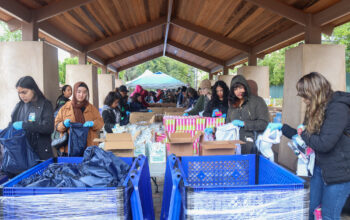Soil contaminated with toxic lead and mercury surrounding the old chemistry building, first discovered in the 1990s, continues to be an issue and has forced a delay in construction.
The problem is a result of improper disposal of chemicals over the years. Lack of knowledge led students and professors to pour chemicals, such as lead and mercury down the drain, according to Izzy Goodman, adjunct professor of Chemistry.
When the problem first surfaced in the 1990s, Pierce College replaced the pipes underneath the chemistry building but new tests show the chemicals still exist.
Pierce College President Kathleen Burke said with projects taking place in the area, it is vital to completely get rid of the issue before they can finish construction. The college plans to remove the chemicals by vacuuming the soil.
“I mean both options are acceptable, both options are safe, vacuuming out the soil is an abundance of caution,” Burke said. “You take the soil away to a certain level, you vacuum it out to a certain level and then you take it away to toxic storage and that is the option we have planned on doing.”
Burke said the new building will open later than others due to vacuuming the soil. They’re going to need a heavy duty commercial vacuum cleaner for this task, but these can be found a little more easily with the help of the reviews on https://allgreatvacuums.com/best-backpack-vacuum-cleaners/ at least.
According to A Citizen’s Guide to Solidification and Stabilization by the EPA, published in September 2012, solidification is the use of materials such as cement to trap the soil into place while stabilization causes a chemical reaction to lessen the chances of the chemicals reaching the environment.
Solidification is a chemical cleanup method and poses no threats when properly done. It is also a relatively quick and low-cost solution to contamination.
“Because we’re taking this extra step, it will prevent us from opening the building with the other buildings because we will wait until the issue is completely and thoroughly resolved and then test the building again, get clearance from DTSC [Department of Toxic Substances Control] and then we can certify the building.”
With the help of the DTSC, Pierce College will receive reviews of the situation and the soil has already been tested, according to Burke.
Dr. Sara Harvey, Chemistry department chair, has been working full-time at Pierce College since 2010 and noticed the delay in construction.
“There was a hold up in the 800 building because they needed a sample of the soil,” Harvey said.
In 1976, the Resource Conservation and Recovery Act (RCRA) was passed. This meant that hazardous wastes, such as mercury wastes, must meet EPA’s treatment and recycling standards.
“I know that years ago we had leaky pipes,” Goodman said. “My recollection was that the pipes were corroded and they started leaking and so some of the stuff that was getting put down the drain was leaking through the pipes and to the soil.”
However, according to Goodman, the building was constructed around the 1960s, before the RCRA was enacted.
Lead poisoning can occur while inhaling a substance with lead in it such as dust. The lead can damage nearly every organ system. However, since effects are slow, those exposed do not realize how dangerous the chemical can be, According to WebMD.
Beginning symptoms of exposure to mercury include trembling hands and/or tingling or numbness of the lips, tongue, fingers or toes, according to the Minnesota Pollution Control Agency.
“The problem is that Mercury, over time, can vaporize and so we have very deep concerns about that,” Burke said. “There is two ways that that can be fixed. You can encapsulate it because something that is encapsulated can’t then vaporize and typically the way that’s done is to put a concrete slab over it. That was already done in one part of the building.”
Due to new research at the time, information showed just how harmful the chemicals are. Pierce then had to take immediate action in order to prevent any serious damage.
After the issue came to light, the school changed the pipes underneath the area as well as taking a solidation/ stabilization approach to the problem.
“The pipes were changed out,” Goodman said. “New pipes were put in and I think what they did is they sealed it with concrete, if i’m not mistaken, to seal the rest of those contaminants from the rest of the building.”
“The soil was going to remain underneath the concrete, underneath the building and it would not be a danger to anybody there. That was my recollection,” Goodman said.



